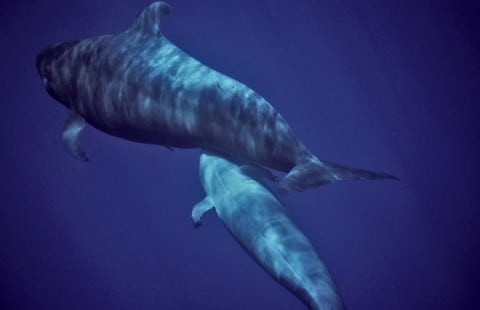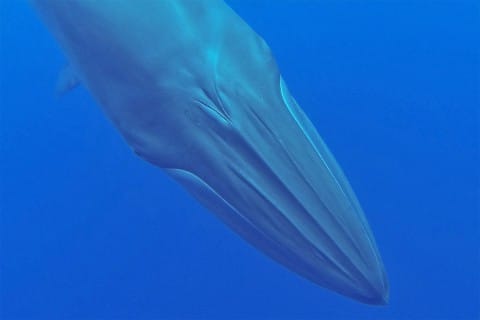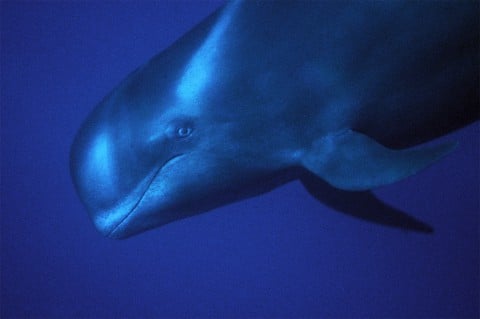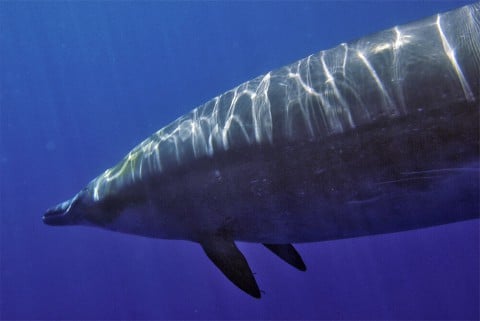About 50 million years ago, the ancestors of the cetaceans lived on land. The transition to a life in the water has made numerous adaptations necessary.
Adaptations of the body

Analyses of fossils show that the whales are descended from land mammals. In the middle Eocene, 50 million years ago, the ancestors of the whales began to adapt to life in the water. During this time they underwent a number of changes:
– The front legs became pectoral fins, the rear limbs disappeared, and they developed a cartilaginous tail fin, the fluke, as their motor. Some species have a stabilising, cartilaginous fin on the back.
– Because of the greater density and resistance of the water, they exchanged all unnecessary appendages, such as auricles and hair for the hydrodynamic shape and smooth skin.

– They have moved the breathing hole (blowhole) to the back of the neck to make it easier to breathe out of the water (a blow consisting mainly of breathing air with condensing water vapour and some water can be seen in the photo).
– They protected themselves against the greater loss of heat in the water with a thick insulating layer of fat, the blubber, and developed ever more enormous body sizes, in which the ratio of mass to body surface area, and thus the loss of heat, became ever lower. The fat also serves them as an energy reservoir.
– Since their bodies are constantly supported by water and carry water better than air, the formation of gigantic bodies was no problem.
Adaptations of the senses

– The sense of touch is not only important on the fins, the whole skin contains a complex system of nerve tracts. For example, they are able to measure the pressure of the water in the area of the blowhole very accurately to detect whether they are close enough to the water surface and to estimate the right moment to start deflating air. Constant contact with conspecifics makes it clear how important physical contact is also from a social point of view.
– The eyes are well adapted to the conditions under water and at least some species see very well above water. Characteristic colour patterns in some species suggest that they can visually recognise each other.
– At great distances, at night or at great depths, and in turbid water, the possibilities for visual orientation are very limited, and even in the best conditions, vision only extends about 30 metres. For this reason, cetaceans communicate and orientate themselves primarily through their hearing. Although they do not have an auricle and their auditory canal is blocked with a wax plug, they hear extremely well. The large rorqual whales seem to be able to communicate over distances of several hundred kilometres and therefore probably produce the greatest sound intensity in the animal kingdom.

Echo localisation or “sonar” has been observed, especially with toothed whales. With lips located below the blowhole, they produce sounds, clicks, which are “radiated” forwards through a lenticular fat body located in the melon and whose echo allows conclusions to be drawn about a body located in the water. The echo is first recorded in the lower jaw and then transmitted via fatty tissue to the inner ear. This is connected to the brain via very strong nerve channels. There are indications that sperm whales can locate a squid from a distance of about 2 km in calm water when there is no background noise.
Here you can hear the recording of a bottlenose dolphin showing how loud it can click.
Physiological adaptations
In order to effectively hunt their prey at great depths, the cetaceans require special abilities in terms of oxygen supply to the body:

– In their lungs, they can use 8 – 12 % of the oxygen in the air with one breath, whereas we only reach 4 %. The lung volume of the pilot whale, for example, is about 10 % of its body size and it exchanges 80 – 90 % of the air with each breath. Whales can therefore replenish their oxygen depot in a short time.
– This depot is not in the lungs. In fact, it collapses at relatively shallow depths (about 80 metres). This means that they exchange gases near the surface and not at great depths under high pressure. Oxygen is stored in the muscles, which contain up to nine times more myoglobin, and in the blood, which can absorb twice as many blood cells as in humans. This means that you do not normally suffer from deep intoxication and do not have problems with pressure equalisation.
– You can generally lower your metabolism rate, cut off the blood supply to specific organs such as the intestinal tract and postpone digestion until later.


